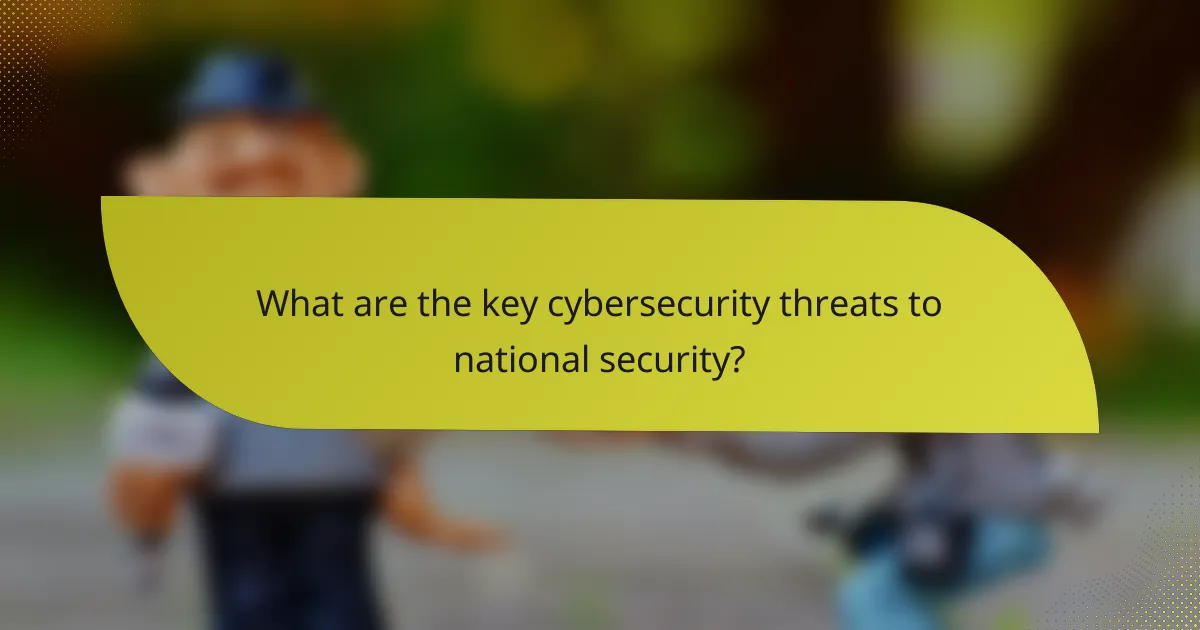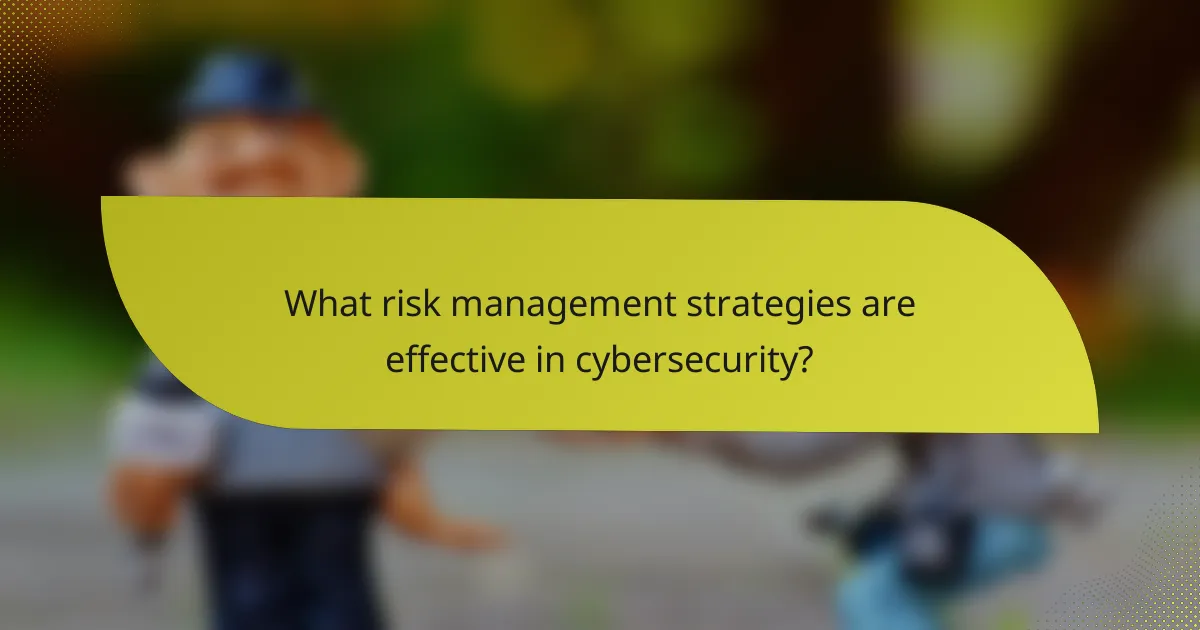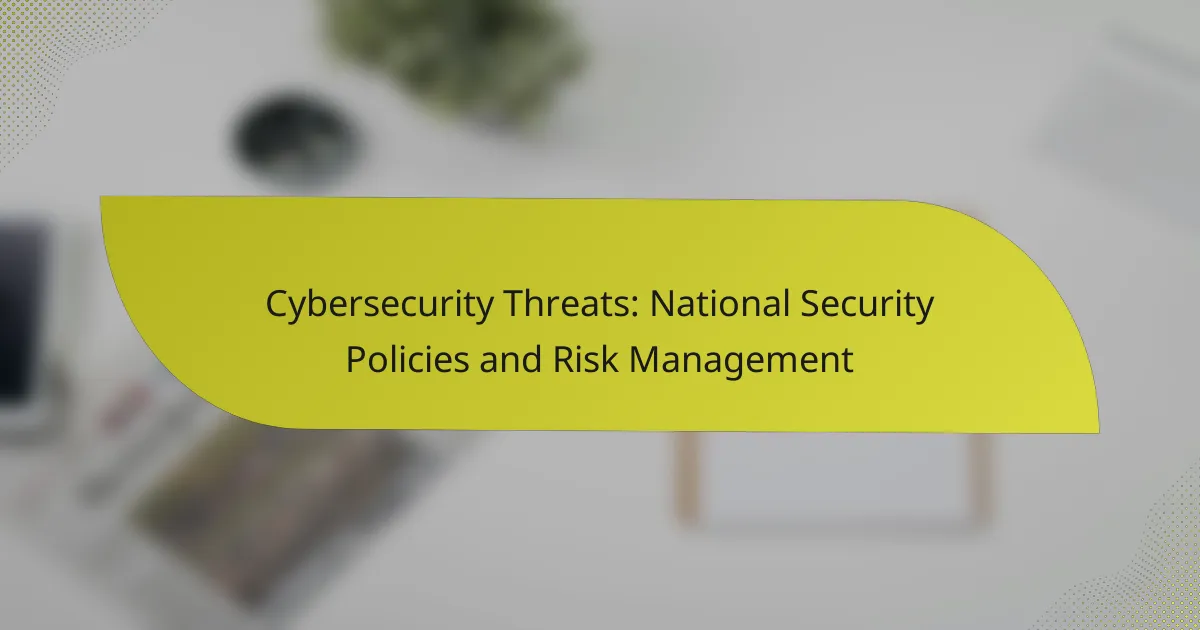In today’s interconnected world, cybersecurity threats pose significant risks to national security, encompassing state-sponsored attacks, ransomware, and insider threats. To combat these challenges, national security policies are essential, providing frameworks and fostering international collaboration to protect critical infrastructure and sensitive information. Effective risk management strategies further enhance resilience by identifying and mitigating potential vulnerabilities, ensuring organizations can respond proactively to emerging cyber threats.

What are the key cybersecurity threats to national security?
Key cybersecurity threats to national security include state-sponsored cyber attacks, ransomware incidents, data breaches, supply chain vulnerabilities, and insider threats. These threats can compromise sensitive information, disrupt critical infrastructure, and undermine public trust in governmental institutions.
State-sponsored cyber attacks
State-sponsored cyber attacks are orchestrated by government entities targeting other nations to achieve strategic objectives. These attacks often focus on critical infrastructure, military systems, or sensitive data, aiming to disrupt operations or steal intelligence.
Countries may use advanced persistent threats (APTs) to infiltrate networks over extended periods, making detection difficult. For instance, attacks attributed to nation-states have targeted energy grids and financial institutions, demonstrating the potential for widespread disruption.
Ransomware incidents
Ransomware incidents involve malicious software that encrypts data, rendering it inaccessible until a ransom is paid. These attacks can paralyze organizations, including government agencies, hospitals, and businesses, leading to significant operational and financial losses.
Victims often face tough decisions regarding whether to pay the ransom, which can range from thousands to millions of dollars. Implementing robust backup systems and employee training can help mitigate the risk of ransomware attacks.
Data breaches
Data breaches occur when unauthorized individuals gain access to sensitive information, often leading to identity theft or corporate espionage. These breaches can result from weak passwords, unpatched software vulnerabilities, or phishing attacks targeting employees.
Organizations must prioritize data protection strategies, including encryption, regular security audits, and employee awareness programs. Compliance with regulations like GDPR or CCPA can also guide effective data management practices.
Supply chain vulnerabilities
Supply chain vulnerabilities arise when third-party vendors or partners introduce security weaknesses into an organization’s network. Cybercriminals exploit these weaknesses to gain access to larger targets, making it essential to assess the security posture of all suppliers.
Conducting thorough risk assessments and requiring compliance with security standards from vendors can help mitigate these risks. Organizations should also consider implementing multi-factor authentication and monitoring systems to detect unusual activities.
Insider threats
Insider threats involve current or former employees who misuse their access to sensitive information for malicious purposes. These threats can be intentional, such as data theft, or unintentional, such as accidental data exposure.
To combat insider threats, organizations should implement strict access controls, conduct regular employee training, and monitor user activities. Establishing a culture of security awareness can also help reduce the likelihood of insider incidents.

How do national security policies address cybersecurity threats?
National security policies tackle cybersecurity threats by establishing frameworks, legislative measures, and fostering international cooperation. These strategies aim to protect critical infrastructure, safeguard sensitive information, and ensure resilience against cyber attacks.
Cybersecurity frameworks
Cybersecurity frameworks provide structured guidelines for organizations to manage and mitigate risks. For example, the NIST Cybersecurity Framework is widely adopted in the United States, offering a flexible approach that organizations can tailor to their specific needs.
These frameworks typically include components such as risk assessment, incident response, and continuous monitoring. Organizations should regularly review and update their frameworks to adapt to evolving threats and technological advancements.
Legislative measures
Legislative measures play a crucial role in defining the legal landscape for cybersecurity. Laws such as the General Data Protection Regulation (GDPR) in Europe impose strict requirements on data protection and breach notification, influencing how organizations manage cybersecurity.
Governments may also implement regulations that mandate cybersecurity standards for critical sectors like finance and healthcare. Compliance with these laws is essential to avoid penalties and enhance overall security posture.
International cooperation
International cooperation is vital in addressing cybersecurity threats that transcend borders. Countries often collaborate through treaties and agreements to share intelligence, best practices, and resources for combating cybercrime.
For instance, initiatives like the Budapest Convention on Cybercrime facilitate cross-border cooperation among nations. Engaging in international partnerships can enhance a nation’s cybersecurity capabilities and foster a unified response to global threats.

What risk management strategies are effective in cybersecurity?
Effective risk management strategies in cybersecurity involve identifying, assessing, and mitigating risks to protect sensitive information and systems. These strategies ensure that organizations can respond to threats proactively and maintain operational resilience.
Risk assessment methodologies
Risk assessment methodologies help organizations identify vulnerabilities and potential threats to their cybersecurity. Common approaches include qualitative assessments, which prioritize risks based on likelihood and impact, and quantitative assessments, which use numerical data to evaluate risks.
Organizations should consider using frameworks like NIST SP 800-30 or ISO 27005 to guide their risk assessment processes. Regularly updating these assessments is crucial, as the threat landscape evolves rapidly.
Incident response planning
Incident response planning involves creating a structured approach to managing cybersecurity incidents. This includes defining roles and responsibilities, establishing communication protocols, and outlining steps for containment, eradication, and recovery.
Effective incident response plans should be tested regularly through simulations or tabletop exercises. This practice helps ensure that all team members are familiar with their roles and can act swiftly when a real incident occurs.
Continuous monitoring practices
Continuous monitoring practices are essential for maintaining an organization’s security posture. This involves the ongoing observation of networks, systems, and user activities to detect anomalies and potential threats in real time.
Organizations can implement tools such as Security Information and Event Management (SIEM) systems to automate monitoring and alerting processes. Regular reviews of monitoring data can help identify trends and inform future risk management strategies.

What role do private companies play in national cybersecurity?
Private companies are essential to national cybersecurity, providing innovative solutions, expertise, and resources that bolster government efforts. Their involvement enhances the overall security posture by integrating advanced technologies and sharing critical information with public entities.
Partnerships with government agencies
Private companies often collaborate with government agencies to strengthen national cybersecurity frameworks. These partnerships can take the form of contracts for services, joint initiatives, or public-private task forces aimed at addressing specific threats.
For example, technology firms may work with the Department of Homeland Security (DHS) to develop cybersecurity strategies that protect critical infrastructure. Such alliances help ensure that both sectors are aligned in their objectives and can respond effectively to emerging threats.
Cybersecurity product development
Private companies are at the forefront of developing cybersecurity products that protect both public and private sectors. They invest in research and development to create advanced tools, such as intrusion detection systems and encryption technologies, that are vital for safeguarding sensitive data.
Many of these products adhere to industry standards like ISO 27001, ensuring they meet rigorous security requirements. Businesses should evaluate these solutions based on their specific needs and the potential return on investment in terms of risk mitigation.
Threat intelligence sharing
Sharing threat intelligence between private companies and government agencies is crucial for effective cybersecurity. This collaboration allows for the rapid dissemination of information about potential threats, vulnerabilities, and attack vectors, enabling a proactive rather than reactive approach.
Organizations can participate in information-sharing platforms, such as the Cybersecurity Information Sharing Act (CISA) in the U.S., which facilitates the exchange of cybersecurity data. Companies should establish protocols for sharing intelligence while ensuring compliance with privacy regulations to protect sensitive information.

How can organizations improve their cybersecurity posture?
Organizations can enhance their cybersecurity posture by implementing comprehensive strategies that include employee training, robust security policies, and regular assessments. Focusing on these areas helps mitigate risks and strengthen defenses against potential cyber threats.
Employee training programs
Employee training programs are essential for improving an organization’s cybersecurity posture. These programs educate staff on recognizing threats, such as phishing attacks, and instill best practices for data protection. Regular training sessions can significantly reduce the likelihood of human error, which is a common vulnerability in cybersecurity.
When designing training programs, consider incorporating interactive elements like simulations and quizzes to engage employees. Aim for a training frequency of at least quarterly to keep security top of mind. Additionally, tailor the content to different roles within the organization, as the risks and responsibilities can vary significantly.
Common pitfalls to avoid include one-off training sessions that lack follow-up and failing to update training materials as new threats emerge. Ensure that employees understand the importance of reporting suspicious activities and provide clear channels for doing so. This proactive approach fosters a culture of security awareness throughout the organization.
